Wednesday, July 9th 2008

Intel Bloomfield 2.66 GHz: First Comprehensive Evaluation
ChipHell carried out the first comprehensive evaluation of the Intel Bloomfield 2.66 GHz processor, a derivative of the eagerly anticipated Nehalem architecture, which already has fan-sites mushrooming all over the internet.
The most prominant benchmarks used by enthusiasts and overclockers, 3DMark Vantage (CPU Tests), Super Pi 1M, Cinebench and SANDRA were run on this processor.
In the 3DMark Vantage test, the processor secured a CPU score of 16294. It crunched Super Pi 1M in 15.475 seconds. With the Cinebench, it secured 3048 with a single thread, the multi-threaded bench belted out 12627 CB-CPU hinting at the processor's high multi-core efficiency. And finally, Bloomfield takes SANDRA out on a date. You have to look at the red dot compared to a QX9770 yourself.
I'm appetised and looking forward to a great processor architecture and so could you.
Source:
ChipHell
The most prominant benchmarks used by enthusiasts and overclockers, 3DMark Vantage (CPU Tests), Super Pi 1M, Cinebench and SANDRA were run on this processor.
In the 3DMark Vantage test, the processor secured a CPU score of 16294. It crunched Super Pi 1M in 15.475 seconds. With the Cinebench, it secured 3048 with a single thread, the multi-threaded bench belted out 12627 CB-CPU hinting at the processor's high multi-core efficiency. And finally, Bloomfield takes SANDRA out on a date. You have to look at the red dot compared to a QX9770 yourself.
I'm appetised and looking forward to a great processor architecture and so could you.
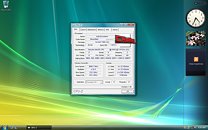
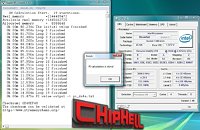
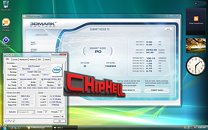
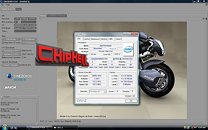
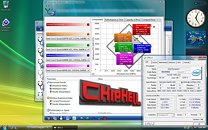
59 Comments on Intel Bloomfield 2.66 GHz: First Comprehensive Evaluation
Sure it'll overclock well like Wolfsdale
the way processors are going these days, it may be better to save up money for a kickass gpu, and just get the budget processor with this architecture and overclock.
The Super Pi for the stock processor is great and all & the vantage score kills all comers too. Intel better not charge 2 arms & a leg for this too since its basically eating through the QXs even at stock.
The only thing I find important with these CPUs isn't the CPU itself but, the plans Intel have to get developers to use HT. The only game that I know of that uses HT is Quake 4. I am sure there are others like Lego but they are hardly CPU demanding.
Because its faster there and has the same instruction set you will deffinetely be faster, how much is questionable, especially being most games wont use quad cores.
It is ONLY 20% faster than my Q6600@2.66 on DDR1 and AGP.
Intel should be embarassed!
This ES CPU is clocked at 2.67GHz @ 1.075 volts, a .101 volt difference. We will know soon enough what the retail version will be like. But when you now plug in that 20% difference (using less power) then we see that Intel is on the right path.
now this made sense to me maybe not you but i took that score and cut it in half to give a DC version a comparo with my 5000BE @3.2ghz its a lot less of a beat you into the floor difference of 27%
1./ Bloomfield = 4 cores and "new" HT = 8 threads
2./ Quick path
3./ DDR3
4./ Bigger cache
5./ Some architectural tweaks other than HT
Yet it is only able to score 4.14x multiplier on CB10 compared to 3.55 on the Q6600. So that means a gain of about 15% due to HT'ing 8 threads over 4 cores. That's not too exciting, because that 15% gain for 4 "extra" hyperthreads is RUBBISH compared to, e.g., a 355% gain for 4 cores instead of 1.
15% vs. 355%? Find me a dual socket Core 2 Quad for the 355%, thanks.
But if 15% gain is coming from HT, and the performance over my Q6600 AGP DDR1 is 20%, the net is 5% for all the other features.
WTF? 5% from:
1./ ...
2./ Quick path
3./ DDR3
4./ Bigger cache
5./ Some architecte tweaks other than HT
If that's really true, those 4 additional "developments" can only win 5%, then Intel has failed with the new architecture and AMD is in with a chance.
*CAVEAT, all commentary based on CB10 and superpi results shown.
Interesting…
A Wolfdale/Yorkfield must be operating at approximately 3.05 GHz to match that 1M SuperPi time and at approximately 2.80 GHz to match that single-thread Cinebench 10 score (according to tests run personally).
In other words, (again, as I personally tested, moments ago) a Wolfdale/Yorkield @ 2.66 GHz achieves a 1M SuperPi time of approximately 18.274 sec. (versus 15.475 sec.) and a single-thread Cinebench 10 score of approximately 2936 (versus 3048). This suggests Bloomfield is 15.3% and 3.8% faster in SuperPi and single-thread Cinebench 10, respectively.
That doesn't say much. However, it does look like Bloomfield's strength will be how well it scales in multithreaded scenarios. But, in terms of single-thread performance, the increase is evolutionary, and very similar to the gains experienced from K8 to K10 (and certainly not comparable to the 40% or so clock-for-clock average gains seen from Presler to Conroe).